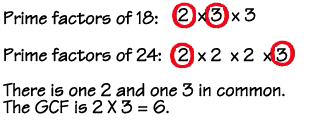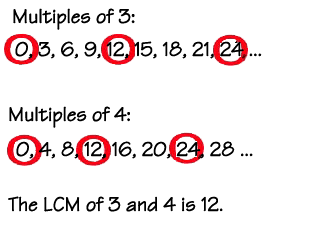GREATEST COMMON FACTOR:
METHOD 1
The greatest common factor, or GCF, is the greatest factor that divides two numbers. To find the GCF of two numbers:
- List the prime factors of each number.
- Multiply those factors both numbers have in common. If there are no common prime factors, the GCF is 1

METHOD 2
It's often useful in solving math problems to be able to find the largest factor that divides two numbers. We call this the greatest common factor, or GCF. Let's find the GCF of 30 and 45. First we find the prime factors of each number, using prime factorization.
30 = 2 × 3 × 5
45 = 3 × 3 × 5
Next, identify those prime factors that both numbers have in common, and multiply them. Here, both 3 and 5 are common factors. The GCF is 3 times 5, or 15.
3 × 5 = 15 <— GCF
EXAMPLES
Find the GCF of these pairs of numbers.
14, 49
Solution: List the prime factors of each.
14: 2 × 7
49: 7 × 77 is the only common factor; therefore, 7 is the GCF.
15, 75
Solution: List the prime factors of each.
15: 3 × 5
75: 3 × 5 × 53 and 5 are common; therefore, 3 × 5 = 15 is the GCF
LOWEST COMMON MULTIPLE
METHOD 1
A common multiple is a number that is a multiple of two or more numbers. The common multiples of 3 and 4 are 0, 12, 24, ....

The least common multiple (LCM) of two numbers is the smallest number (not zero) that is a multiple of both.

METHOD 2
The least common multiple, or LCM, is another number that's useful in solving many math problems. Let's find the LCM of 30 and 45. One way to find the least common multiple of two numbers is to first list the prime factors of each number.
30 = 2 × 3 × 5
45 = 3 × 3 × 5
Then multiply each factor the greatest number of times it occurs in either number. If the same factor occurs more than once in both numbers, you multiply the factor the greatest number of times it occurs.
Then multiply each factor the greatest number of times it occurs in either number. If the same factor occurs more than once in both numbers, you multiply the factor the greatest number of times it occurs.
2: one occurrence
3: two occurrences
5: one occurrence
2 × 3 × 3 × 5 = 90 <— LCM
After you've calculated a least common multiple, always check to be sure your answer can be divided evenly by both numbers.
Some word problems: Click here
Some word problems: Click here
INTEGERS
No hay comentarios:
Publicar un comentario